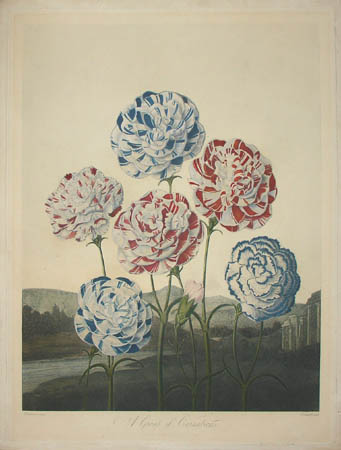Description
Robert John Thornton began his career as a doctor. In 1797, he opened a successful practice in London. Meanwhile, he had become deeply interested in botany under the influence of Thomas Martyn’s lectures and the writings of Linnaeus. In 1797, he also began advertising for subscribers to his planned natural history publishing venture, which eventually became known as The Temple of Flora, comprised of 30 folio botanical plates (generally issued with just 28), as well as two classical allegorical plates. It was originally published as the third section of an extensive and ambitious botanical publication titled New Illustration of the Sexual System of Linnaeus.
Thornton retained some of the best artists of the day to compose the various images, as well as the best engravers to translate their work into print. Most of the images were painted by Peter Charles Henderson and Philip Reinagle, with two by Abraham Pether, who also rendered the moonlight in Reinagle’s Night-blowing Cereus, one of the best-known images from the set. The remaining two plates were painted by Sydenham Edwards and Thornton himself, who created the famous plate of Roses. The engravers were a similarly distinguished group, including Richard Earlom, James Caldwall, Thomas Sutherland, and Joseph Constantine Stadler. Some of the plates are executed in one engraved or etched medium, some in a combination of two or more, including stipple engraving, aquatint, and mezzotint. They were printed in basic colors and then enhanced with hand coloring.
In 1812, Thornton had The Temple of Flora set re-engraved on a small scale for a quarto edition, with some of the compositions slightly altered. Some examples from the smaller formatted edition may have been given as prizes during the Royal Botanic Lottery under the patronage of the Prince Regent. Thornton organized the lottery when faced with bankruptcy after sales of the folio publication failed to recoup his investment, having spared no expense in its production. The lottery apparently failed to salvage his finances, and Thornton died with little money. The whereabouts of the original paintings, also included in the lottery are mostly unknown. Nevertheless, The Temple of Flora remains admired as the greatest illustrated botanical set ever published in Britain for its outstanding aesthetic and imaginative qualities.
Scholar Rodney King described this print as follows: “Carnations are cultivated forms of Dianthus caryophyllus. Many varieties have been bred such as those shown in this picture, which was painted by Peter Henderson. These belong to what are called ‘florist’s flowers,’ that is, varieties conforming to certain recognized standards. Those with broad stripes of one colour were classed as ‘Flakes’: the Flakes in this group were named by Thornton ‘Palmers’s Dutchess of Dorset’ and ‘Palmer’s Defiance’. Those with stripes of two or three colours were known as ‘Bizarres’: Thornton called the Bizarres in this group ‘Caustin’s British Monarch’ and ‘Midwinter’s Dutchess of Wurtemburg.’ Those with toothed and coloured edges to the petals were ‘Piquettes,’ in this case ‘Davey’s Defiance’ and ‘Princess of Wales.'” (Ronald King. The Temple of Flora by Robert Thornton. 1981, p. 60).
Condition: Generally very good with the usual overall toning and wear. Professionally cleaned leaving very faint line from former matting. Minor abrasions to margins from former matting, unobtrusive and can be rematted out. Two small pale foxing spots, left side above mountains, unobtrusive. Plate marks all present and margins ample. Publication line beneath title a little faint.
References:
Blunt, Wilfred, rev. by Stearn, William T. The Art of Botanical Illustration. Woodbridge, Suffolk, England: Antique Collectors Club, 1994. pp. 236-242.
Dunthorne, Gordon. Flower and Fruit Prints of the 18th and Early 19th Centuries. Their History, Makers and Uses, with a Catalogue Raisonne of the Works in Which They are Found. Washington, D.C.: Published by the Author, 1938.
Grigson, Geoffrey and Handasyde Buchanan. Thornton’s Temple of Flora. London: 1951.
King, Ronald, The Temple of Flora by Robert Thornton, London, Weidenfield & Nicolson, 1981.
Sitwell, Sacheverell. Great Flower Books, 1700-1900. New York: The Atlantic Monthly Press, 1990. pp. 77, 127.
Stafleu, Frans A. and Richard S. Cowan. Taxonomic Literature. Utrecht: 1967. 2nd ed., Utrecht: 1976-1988. TL2 8319, Tl2 14.283.
Thomas, Alan G. Great Books and Book Collectors. Littlehampton Book Services, 1975. p.144.
Thornton, Robert John and Mrs. Robert W. Ballantine. New Illustration of the Sexual System of Carolus von Linnaeus: and the Temple of Flora, or Garden of Nature. London: 1807. Online at Missouri Botanical Garden: http://www.illustratedgarden.org/mobot/rarebooks/library.asp?relation=QK91C7721807 (15 January 2013).






